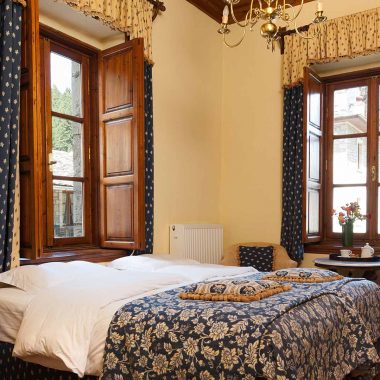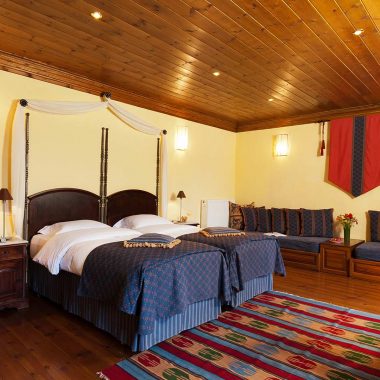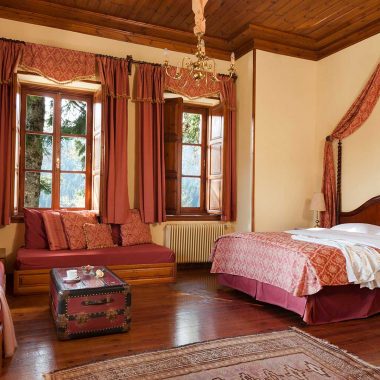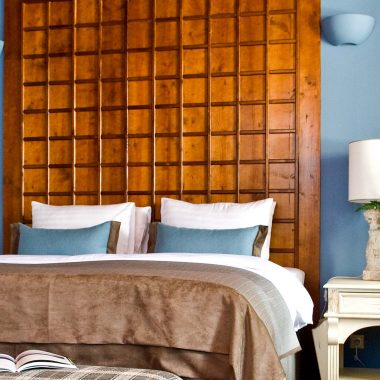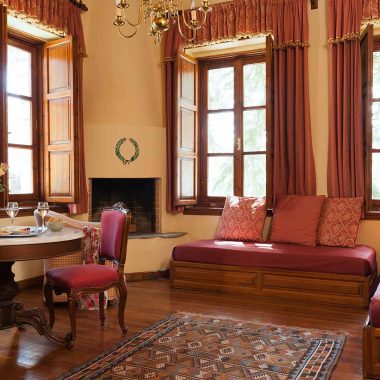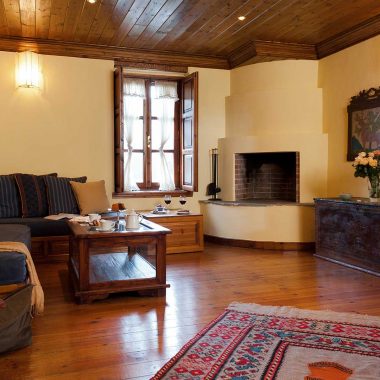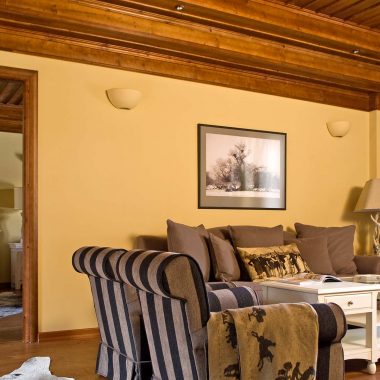Pertouli
Pertouli
information about the village and its history
Pertouli is located in the Prefecture of Trikala, in the Pindos mountain range, nestled on the slopes of Boudoura at an altitude of 1.150m, 45 km from the town of Trikala, the prefecture’s capital. Driving from Trikala, the Pertouli area begins as one enters the dense forest and the meadows. At this point the waters of the mountain streams, which have joined into one, diverge into two streams, one of them joining the river Pinios towards the east, the other joining the Aspropotamos, also known as the Acheloos . In the southwest part of the village, near Neraidohori, a vertical rock that adjoins the National Road from Trikala to Arta constitutes the natural boundary between the two villages (Pertouli–Neraidohori). Pertouli is the easternmost village of the 32 ‘Vlachohoria’ of the alpine area of the Aspropotamos.
Pertouli is surrounded by the fir-covered mountains of Pindos: Koziakas (the ancient Kerkitios, which is 25km long, 1,901m high and belongs to the category of the Austrian Mountains Karst), the Boudoura Mountains (or Vigga), Mount Berta (or Vathi), and the mountains of Fourka, Giona, and Keptinelo. The imposing peak of Marosa, towards the south, completes the surrounding rock wall. The forest of Pertouli covers an area of 33,000 stremmas (825 acres) and belongs to the State, its use granted to the University of Thessaloniki in 1934 for the training of forestry students and for scientific research.
The village faces towards the east, built along the Trikala-Arta segment of the National Road on three to four levels, which are defined by parallel streets. It has 150 buildings (residences, churches, schools, shops, hotels and guest-houses, as well as university facilities) and is aesthetically appealing, seeming to blend completely into the natural environment, with all residences conforming to the local architectural style, the houses built of local stone, with slate roofs. The university buildings stand out, due to their design by the noted Greek architect, Dimitris Pikionis. Despite some modern influences, many of the new, as well as the post-war buildings, are quite striking.
Pertouli is notable for the natural beauty that surrounds it, along with its centuries of history and the magnificent tower-homes built by the many prominent families that established the village as a focal point of the Prefecture of Trikala. These families nurtured politicians, scholars, intellectuals and businessmen with considerable influence in Greek society. Today it has around 250 residents and many seasonal residents– the Vlachs and the Sarakatsani– who are mostly shepherds who transfer livestock from the lowlands to the highlands with the changing of the seasons. The Vlachs are an eastern Romance language-speaking group, whom the historians believe to be the descendants of intermarriage between the Romans legions in Greece during the second century B.C and the local Greeks. The Sarakatsani speak a northern dialect of Greek and are commonly believed to be descended from the Dorians, who were isolated for centuries in the mountains. On the last Sunday of June, Sarakatsani from all over Greece and the Balkans gather at an annual festival to celebrate their customs and lifestyle. In general, the inhabitants of Pertouli are engaged in livestock farming, logging, and tourism.
Accommodation
We spent a most enjoyable and picturesque Easter in your village. Your hotel is located in a great spot, with stunning views, and all of your amenities are perfect. We were very happy with your hospitality. At the earliest opportunity, we promise to visit you again.
subscribe to our newsletter
to receive exclusive offers and news from Chatzigaki Manor


